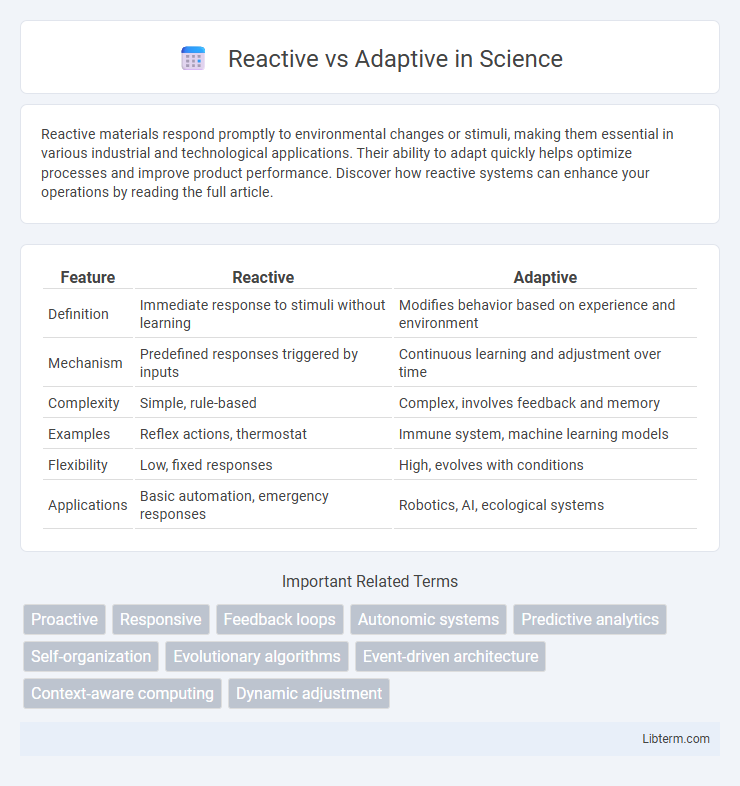Reactive materials respond promptly to environmental changes or stimuli, making them essential in various industrial and technological applications. Their ability to adapt quickly helps optimize processes and improve product performance. Discover how reactive systems can enhance your operations by reading the full article.
Table of Comparison
| Feature | Reactive | Adaptive |
|---|---|---|
| Definition | Immediate response to stimuli without learning | Modifies behavior based on experience and environment |
| Mechanism | Predefined responses triggered by inputs | Continuous learning and adjustment over time |
| Complexity | Simple, rule-based | Complex, involves feedback and memory |
| Examples | Reflex actions, thermostat | Immune system, machine learning models |
| Flexibility | Low, fixed responses | High, evolves with conditions |
| Applications | Basic automation, emergency responses | Robotics, AI, ecological systems |
Understanding Reactive and Adaptive Approaches
Reactive approaches respond to changes after they occur, often relying on pre-defined rules and immediate adjustments, while adaptive approaches anticipate changes by continuously learning and evolving from new data and experiences. Understanding reactive methods highlights their efficiency in handling known issues quickly, but they may struggle with unforeseen challenges. Adaptive approaches emphasize flexibility and resilience, enabling systems to modify behavior proactively based on evolving contexts and long-term trends.
Core Principles of Reactive Systems
Reactive systems prioritize responsiveness, resilience, elasticity, and message-driven communication to handle real-time interactions and failures efficiently. They maintain system stability by asynchronously processing messages, ensuring low latency and high throughput under varying workloads. Adaptive systems build on these principles by dynamically adjusting resource allocation and behavior based on environmental changes, enhancing system flexibility and scalability.
Key Characteristics of Adaptive Systems
Adaptive systems exhibit self-learning capabilities, enabling them to adjust behavior based on environmental feedback without explicit external control. They prioritize flexibility and robustness, continuously evolving to handle unforeseen changes through dynamic reconfiguration. Key characteristics include real-time data processing, autonomous decision-making, and resilience to complex, unpredictable scenarios.
Reactive vs Adaptive: Fundamental Differences
Reactive systems respond to changes or stimuli after they occur, relying on predetermined rules or fixed responses, while adaptive systems proactively adjust their behavior based on real-time feedback and evolving conditions. Reactive approaches prioritize immediate, moment-to-moment reactions without altering underlying processes, whereas adaptive approaches modify internal mechanisms to improve performance over time. The fundamental difference lies in the capacity for learning and self-modification, with adaptive systems exhibiting continuous improvement and resilience beyond fixed reactive patterns.
Advantages of Reactive Methodologies
Reactive methodologies offer significant advantages such as rapid response to change, enabling teams to quickly adapt to evolving project requirements and market conditions. They promote flexibility and continuous feedback, which enhances collaboration and reduces the risk of costly errors by addressing issues as they arise. This approach is particularly effective in dynamic environments where customer needs and technological factors fluctuate frequently.
Benefits of Adaptive Strategies
Adaptive strategies enhance organizational resilience by enabling continuous learning and timely adjustments to changing market conditions. They foster innovation through iterative feedback loops, allowing companies to anticipate disruptions and maintain competitive advantage. Emphasizing flexibility, adaptive approaches reduce risks associated with uncertainty and improve long-term sustainability.
Use Cases: When to Choose Reactive Solutions
Reactive solutions excel in scenarios requiring immediate response to real-time events, such as fraud detection, system monitoring, and user interaction management. Use cases involving unpredictable workloads or continuous data streams benefit from reactive architectures to maintain low latency and high throughput. Enterprises aiming to build scalable, event-driven systems prioritize reactive models to handle asynchronous data with resilience and elasticity.
Use Cases: When to Choose Adaptive Solutions
Adaptive solutions excel in dynamic environments requiring continuous learning and real-time decision-making, such as personalized marketing, predictive maintenance, and intelligent supply chain management. These systems adjust proactively to evolving data patterns and user behaviors without manual intervention, making them ideal for complex scenarios with high variability. Choosing adaptive solutions enables businesses to enhance responsiveness, optimize performance, and maintain competitive advantage in rapidly changing markets.
Challenges in Implementing Reactive and Adaptive Approaches
Organizations face significant challenges when implementing reactive strategies, including delayed response times, lack of proactive planning, and difficulty in managing unforeseen disruptions. Adaptive approaches require continuous monitoring, real-time data analysis, and flexibility in processes, which demand advanced technology integration and skilled personnel. Balancing resource allocation between immediate problem-solving and long-term adaptability remains a critical obstacle in successfully deploying both reactive and adaptive systems.
Future Trends: Evolving from Reactive to Adaptive
Future trends emphasize the shift from reactive systems, which respond to problems after they occur, to adaptive systems that anticipate changes and adjust proactively through AI-driven analytics and real-time data integration. Organizations investing in adaptive technologies benefit from enhanced resilience, personalized user experiences, and optimized operational efficiency. This evolution leverages machine learning, IoT, and edge computing to enable continuous self-improvement and dynamic decision-making.
Reactive Infographic

 libterm.com
libterm.com